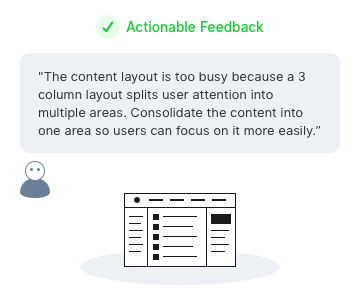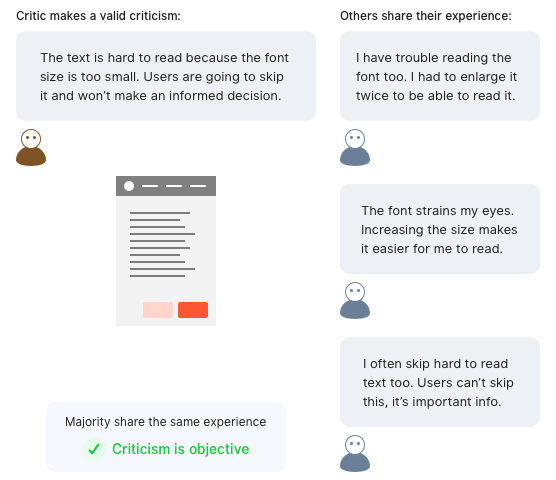Every designer receives feedback on their designs when working with others. But not every designer receives actionable feedback they’re confident applying to their design. They often get unactionable feedback that frustrates and confuses them.
What’s the difference between the two and how can designers prevent unactionable feedback and ensure they get actionable feedback?
Unactionable Feedback
Unactionable feedback is vague and only tells you there’s a problem, but doesn’t tell you the specifics behind the problem. Designers get frustrated because they don’t get direction on how to improve the design. This makes it harder for them to meet expectations and tackle user experience problems.

Unactionable feedback is also subjective. The critics who give feedback have their own biases. Applying their biased feedback to your design will lead to a design that fails to meet user needs. You’ll waste a lot of time with unnecessary revisions if you don’t vet the feedback you’re getting.
Actionable Feedback
Actionable feedback is what you get when you vet feedback. It offers you specifics on why and how an aspect of your design isn’t meeting user needs. This specificity prevents you from misinterpreting the feedback and doing wasteful work. It gives you clear direction on what the problem is so you can solve it.

Actionable feedback is also objective. If the feedback you get is only coming from one person, it’s biased. You need a group of people to check if the majority experiences the same issue. This group can consist of your co-workers, clients, or users.
If the majority do experience the same issue, the feedback is objective and is actionable. If the majority don’t experience the same issue, the feedback is subjective and you should discard it.
Design Vetting for Checking Criticisms
Design vetting allows you to check criticisms for objectivity. For example, you may get criticism that the text on your interface is difficult to read. You don’t know if this critic’s claim is objective until you get feedback from more people. If the majority also have trouble reading your text, you can conclude that the criticism is objective.

When others share their experience on the issue, they should be specific with how it affects them. These details are encouraged so that everyone can get an accurate description of each person’s genuine experience.
If the majority don’t experience an issue the same way, the criticism is subjective. When this occurs, the criticisms should not be applied to the design. It’s the group’s experiences that determine what’s objective, not any one person’s judgment.

Design Vetting Stages
Design vetting has three stages to ensure you get feedback is specific, objective, and focuses on user needs.

Stage 1: Criteria
The first stage is where you create criteria for vetting based on universal design principles. Your team will use this to identify aspects of the design that violate the criteria. This is done to keep their criticisms relevant and focused on user needs.
Stage 2: Validity
The second stage is where you check to see if each criticism you get includes the specific reasoning behind it and focuses on user needs. If they don’t, it’s your job to solicit it from the critic.
Stage 3: Objectivity
The third stage is where you check to see if everyone else on your team agrees with the criticism. Their agreement will be based on their own experience, not a popularity vote.
The Book
Design vetting is easy to do once you learn how to do it. The book Design Vetting: A Process for Getting Actionable Feedback On You Designs will guide you through each stage and show you how it all works.
It’s time for designers to stop accepting subjective feedback and to vet it for objectivity. Feedback is so useful for improving your design through each iteration. But if the feedback is subjective, it’ll do your design more harm than good.


With respect, it’s a designers job to make ‘unhelpful’ or vague responses useful. Just because someone doesn’t know how to play the piano doesn’t mean they can’t tell when something is off and just because they can’t put their finger on it doesn’t make their feedback ‘unactionable’.
If the designer can’t put their finger on what’s wrong after the feedback is given, the critic is likely not being explicit and specific. The designer’s job is not to guess, assume, or mind-read what the critic means, but to prompt the critic to be explicit and specific so that the feedback can be properly vetted.
Vague responses are not useful and Design Vetting is about designers holding critics accountable to the feedback they give.